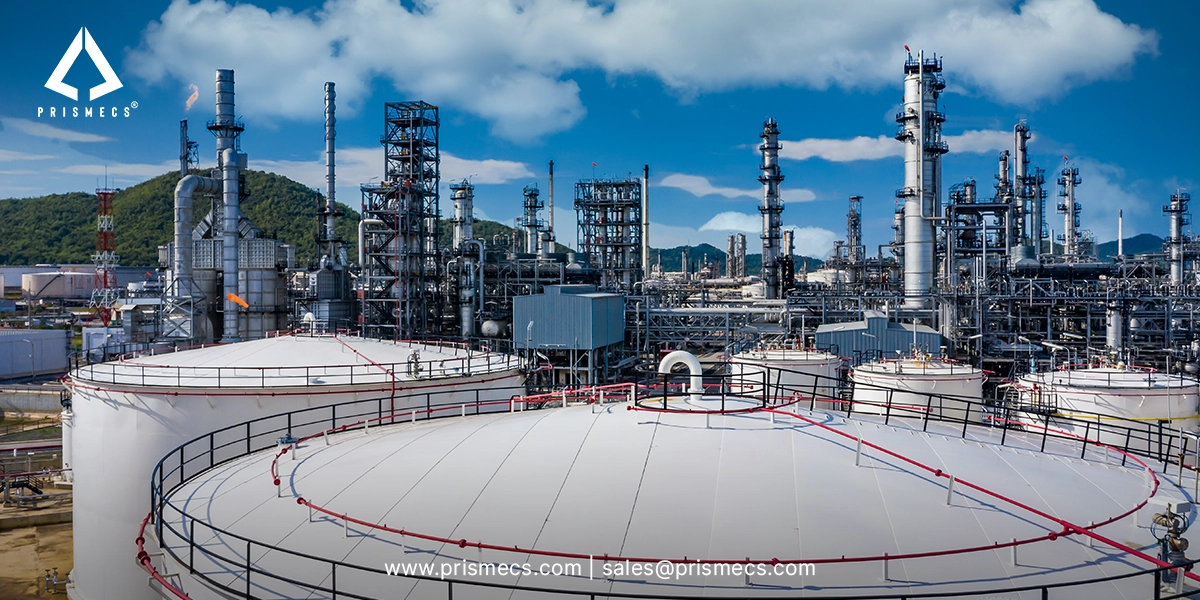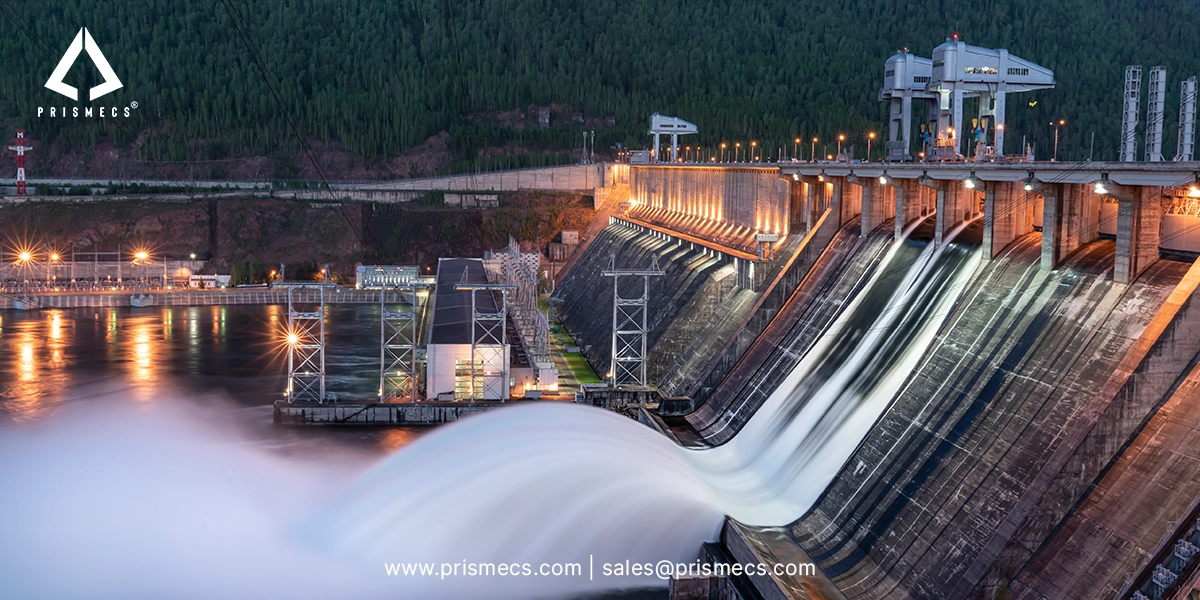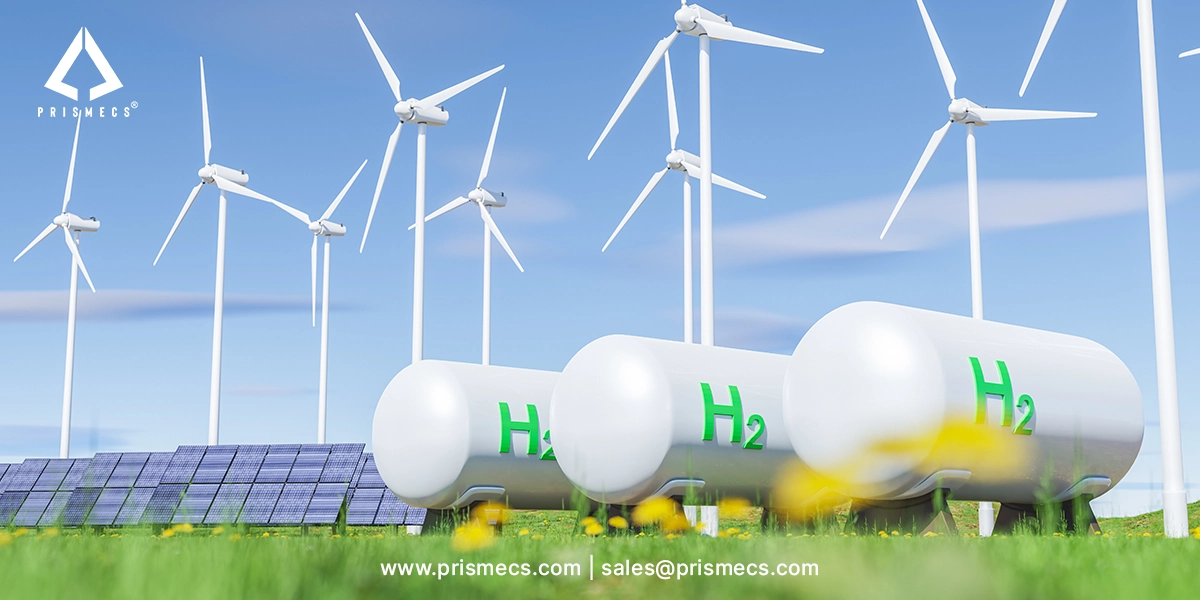
Lately, the world is moving towards sustainable energy because of climate change and the need to reduce greenhouse gases. Among the promising technologies emerging at the forefront is green hydrogen, deemed as a potential game-changer in the quest for clean energy sources.
In this comprehensive blog, we explore what green hydrogen is, how we produce it, its environmental benefits, and its role in shaping the future of energy.
The Production of Green Hydrogen
The commercial viability of green hydrogen production heavily relies on the availability and efficiency of renewable energy sources. We enhance techniques like water electrolysis, which uses an electrical current to break down water into hydrogen and oxygen, by integrating wind and solar power. This facilitates not only a reduction in operational costs but also bolsters the sustainability of hydrogen as a truly green fuel.
Developing a robust infrastructure for producing green hydrogen is crucial. For instance, large-scale hydrogen projects across the globe are tapping into areas rich in renewable resources to set up extensive solar farms and wind turbines that directly feed into electrolyzes, optimizing the production process.
Green Hydrogen Can Help Meet Climate Targets
- It can help meet climate targets by reducing greenhouse gas emissions. It can replace fossil fuels in various sectors, reducing emissions in those sectors.
- It significantly contributes to grid stabilization. It enables the increased deployment of renewable energy sources.
Green Hydrogen in Power Generation and Energy Storage
Green hydrogen plays a crucial role in power generation and energy storage, providing solutions to some of the biggest challenges in renewable energy. We can store hydrogen for long periods and reconvert it to electricity in fuel cells for later use, solving the intermittent issues of solar and wind power. This energy storage capability ensures a stable and reliable energy supply even when the sun doesn't shine, or the wind doesn't blow.
Global Progress and Notable Projects
The global commitment to reducing carbon emissions has catalyzed numerous national and international green hydrogen initiatives. Projects totaling a million tons of capacity are underway, signifying a monumental leap in scaling up green hydrogen infrastructure.
For instance, the European Union has launched the European Hydrogen Strategy to increase green hydrogen production to revamp the bloc’s energy system and reduce reliance on natural gas.
Countries like Germany and Australia are at the forefront, engaging in bilateral partnerships to establish green hydrogen as a traded commodity, thereby setting the foundations for a new global energy market.
Scaling Production and Meeting Energy Demand
The challenge of scaling green hydrogen production to meet global energy demand significantly revolves around cost and technological innovation. Electrolyze technologies, crucial for producing hydrogen, still need substantial advancements to become economically viable at a large scale. Moreover, significant investments in renewable power generation capacities are essential to ensure there's enough electricity to produce hydrogen without compromising the needs of existing grids.
Green Hydrogen Market Size
Experts forecast the green hydrogen market to surge to USD 10.55 billion by 2030 with a remarkable compound annual growth rate (CAGR) of 57.41% from 2024 to 2030. Increasing demand for renewable energy sources and the imperative to curb carbon emissions primarily drive this growth.
The Green hydrogen market industry is projected to increase from USD 0.44 billion in 2022 to USD 10.55 billion by 2030.
Achieving this milestone is a prerequisite for the future of the planet and the stability of the global economy. The report "Net Zero by 2050: A Roadmap for the Global Energy Sector," published by the IEA in 2021, outlines a realistic pathway for the global energy sector to achieve net zero emissions by 2050.
Challenges and Commercial Opportunities
To unlock the vast potential of green hydrogen, we must address several challenges while realizing its widespread adoption.
- Cost
The high cost of electrolyzing and renewable energy sources poses a significant barrier to the commercialization of green hydrogen. Declining renewable energy costs and improved electrolyze efficiency reduce green hydrogen production expenses.
- Infrastructure
The development of infrastructure for green hydrogen production, storage, transportation, and distribution is crucial for its commercial viability. A robust hydrogen infrastructure network, including hydrogen refueling stations, pipeline systems, and storage facilities, needs public and private investments to be built.
- Market Adoption
Growing awareness of green hydrogen's environmental benefits, along with regulations and corporate sustainability goals, drives demand for renewable energy solutions. Companies in diverse sectors explore integrating it, fostering new revenue streams, and bolstering environmental credentials.
The Expense of Green Hydrogen is decreasing
The cost of producing green hydrogen is declining as technology matures and demand grows. The International Energy Agency predicts its cost will fall by up to 80% by 2030. This cost reduction will make it more competitive. It will make it an increasingly attractive investment for a decarbonized future.
Environmental Impacts and Benefits
One of the most lauded aspects of green hydrogen is its potential to significantly reduce greenhouse gas emissions. By replacing fossil fuels in sectors like transportation and manufacturing, green hydrogen contributes to cleaning up industrial processes and vehicular emissions, both major sources of pollution.
For example, integrating hydrogen fuel cells into the power generation systems of industrial plants can drastically cut down the amount of carbon released into the atmosphere.
Similarly, replacing diesel engines with fuel cell power in buses and trucks can transform public and cargo transportation into cleaner systems.
Regulatory and Economic Considerations
For green hydrogen to truly redefine the global energy landscape, supportive regulatory frameworks and economic incentives are critical. Policies that encourage investment in renewable energy and technology, carbon pricing mechanisms, and subsidies for developing hydrogen infrastructure can accelerate adoption and reduce the overall cost of green hydrogen production.
The Road Ahead
Technological innovations and growing governmental support are likely to drive down costs and scale up production capabilities in the coming years. The global push towards renewable electricity and the integration of technologies like green hydrogen into the energy matrix highlights an enriched path to a sustainable future.
Green hydrogen stands not only as a symbol of innovation but also as a practical solution to the world's urgent energy demands and environmental needs. In this grand energy transition, green hydrogen is not just a potential replacement for fossil fuels but a key player in a new ecological paradigm that promotes sustainability, energy security, and economic growth.
How Prismecs can help you unlock the potential of green hydrogen as the ultimate solution for sustainable energy?
We offer a comprehensive suite of solutions tailored to this emerging green hydrogen market. Our expertise spans the entire value chain—from innovative production technologies and efficient storage solutions to seamless integration with renewable energy sources like wind and solar.
By partnering with us, you gain access to cutting-edge solutions, strategic insights, and practical implementation strategies that ensure your green hydrogen projects are both viable and sustainable.
Contact Prismecs As a trusted partner, you can harness the potential of Green Hydrogen to forge a more sustainable future. To avail of our services, call us at +1 (888) 774-7632 or email us at sales@prismecs.com.
Frequently Asked Questions (FAQs)
1. What is green hydrogen, and how is it different from other types of hydrogen?
Green hydrogen is produced using renewable energy sources, such as wind and solar power, through a process called electrolysis, which splits water into hydrogen and oxygen. This method results in zero carbon emissions, making it sustainable and environmentally friendly.
2. How does green hydrogen contribute to reducing greenhouse gas emissions?
Green hydrogen helps reduce greenhouse gas emissions by providing a clean energy source that can replace fossil fuels in various sectors, including transportation, industry, and power generation.
3. What are the main challenges in scaling up green hydrogen production?
The main challenges in scaling up green hydrogen production include the high costs of electrolyzers and renewable energy, the need for substantial investments in infrastructure, and the requirement for technological advancements to improve efficiency.
4. What role does green hydrogen play in energy storage and grid stabilization?
Green hydrogen is crucial for energy storage, storing excess renewable energy as hydrogen. It can be converted back into electricity using fuel cells, ensuring a stable energy supply when wind and solar power are unavailable.
5. What are some notable global projects and initiatives focused on green hydrogen?
Several countries and regions are investing heavily in green hydrogen projects. For example, the European Union has launched the European Hydrogen Strategy to boost green hydrogen production and reduce reliance on natural gas.
Tags: Green Hydrogen Sustainable Energy Renewable Energy Clean Energy Hydrogen Fuel Energy Transition Eco Friendly
recent posts

Petrochemicals
6 minutes read
Petrochemical EPC Services for Complex Plant Projects
Complete complex petrochemical projects with expert EPC services. Prismecs ensures safety, compliance, and on-time delivery. Partner with us today.

Renewables
5 minutes read
How Renewable Energy Systems Work Efficiently
Maximize efficiency with Prismecs’ renewable energy systems. Scalable, reliable solutions help industries cut costs, reduce emissions, and achieve sus...

I and C Services
7 minutes read
Expert Commissioning Services for Safe, Efficient Operations
Ensure safe, efficient energy operations with Prismecs commissioning services. Optimize energy systems, improve reliability, and reduce operational ri...

Green Hydrogen
7 minutes read
Green Hydrogen Plant Technology Guide
Discover how green hydrogen plants deliver zero-carbon energy. Prismecs guides scalable production, storage, and renewable integration. Act now for cl...